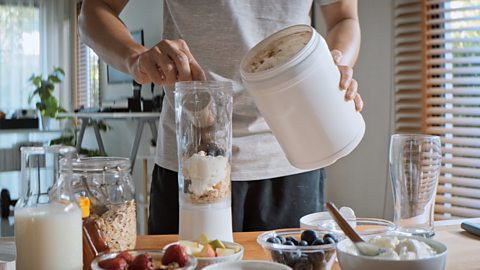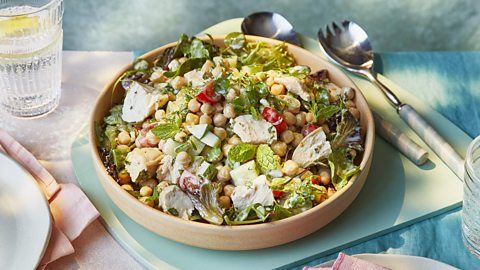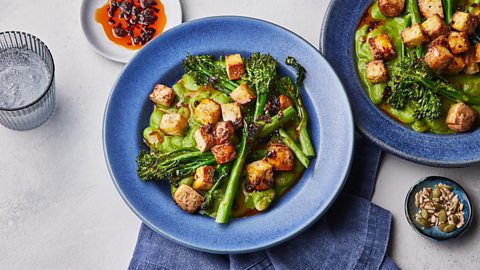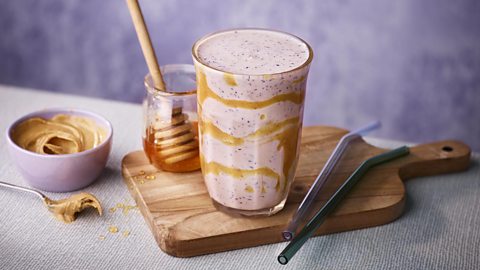Is the protein craze a problem for the environment?
Social media, food manufacturers and some nutrition experts are urging us to eat more protein. We investigate what impact this could have on the environment – and whether it’s even necessary.
By Sue Quinn

As a nation, we’re increasingly focused on packing more protein into our diets.
“Fifteen percent of people listed high protein content as one of their three most important factors in healthy foods in late 2019, climbing to 21% by late 2024 (including 39% of under-35s),” says Kiti Soininen from market research company Mintel.
Social media influencers are encouraging us to eat more than the recommended amount, while searches on the same platforms for #protein are soaring (there are more than 30 million posts with that tag on Instagram alone).
Supermarket shelves are lined with more products than ever claiming to be high in protein – from snack bars to bottled water – and the UK’s protein powder market more than trebled in value between 2012 and 2023.
There’s no denying that our bodies need protein to function healthily (it helps to build and repair tissues, support the immune system and maintain healthy muscles, organs and bones), but consuming excessive amounts may not only be unhelpful for our bodies, it could also have consequences for the environment.
Fish is a great source of protein and this salmon traybake is easy to make
The environmental impact of protein
“If you choose animal-based proteins to increase your intake, you up your environmental footprint quite a bit,” says Dr Marco Springmann, co-author of the 2019 EAT-Lancet report, which outlined the Planetary Health Diet.
Meat from ruminants like cattle and sheep has the greatest environmental impact due to methane emissions, he says. But chicken – a popular protein source – is not far behind, having 10 times the impact of any plant-based protein source.
Legumes, such as beans, lentils and peas, have “close to nothing” in terms of emissions and environmental impact, points out Springmann, making them an ideal alternative for those looking to increase their protein intake without harming the planet.
Protein powders made from whey, pea or soy, and products containing isolates (concentrated proteins derived from these ingredients) fall somewhere in between animal and plant-based proteins in terms of their environmental impact, Springmann says.
It all depends on how they are manufactured. For example, in the UK, whey powder is derived from the by-product of cheese production, but not all dairy farmers are committed to sustainable practices.
“Generally, these products have a higher environmental impact than the source ingredient because they’re processed, but a lower impact than meat or dairy,” Springmann says. He recommends sourcing these products carefully to be sure they come from companies committed to sustainability.
Sustainable animal sources
Patrick Holden, founder of the Sustainable Food Trust – a charity advocating for regenerative agriculture and sustainable food systems – believes that not all animal protein sources are environmentally harmful.
“It’s not the cow, but the how,” he says. “If we want our diet to be nature- and climate-friendly, we should be eating foods from regenerative farming systems – mainly, or even exclusively, grass-fed beef, lamb and dairy products.”
Holden argues that industrial chicken production is “environmentally disastrous”, whereas red meat from grass-fed ruminants can be part of the solution to climate change.
Chicken salad
Boost your meat with plant-based proteins – this salad includes chickpeas as well as chicken

“If your budget doesn’t stretch to organic chicken, then honestly, you’re better off eating red meat from pasture-fed systems,” he says.
He also believes milks, cheese and other dairy can be sustainable if sourced from pasture-fed cows. For eggs, he advises, “Organic is best, but free-range is a good option if you can’t afford organic.”
On whey protein powders, he warns that most come from large industrial dairies, making it difficult to verify sustainable sources.
“Our food system has become so industrialised that it’s now harder than it should be to get proper, protein-rich diets from truly sustainable sources. But that can change – and it needs to change.”
Plant-based options
For those looking to boost their protein intake but limit their consumption of animal products, vegan chef Day Radley, founder of The Vegan Chef School, says there are simple ways to make plant-based sources more appealing.
“Pairing legumes with something that has a meaty flavour or texture is a great idea. For example, mushrooms and aubergines can really boost the savouriness of a dish like veggie chilli, and adding ingredients like yeast extract or miso paste adds umami flavour.”
Radley also recommends finding creative ways to use plant-based proteins to keep meals interesting.
“You can make fishless fingers by mashing together chickpeas, tinned jackfruit and toasted seaweed for that fishy flavour. Or try scrambled tofu with chickpea flour for extra texture.”
Miso, tahini and spinach butter beans
This dish includes butter beans and tofu for a high protein kick

Pressing and marinating firm tofu can make a big difference to its texture and flavour. For a simple and delicious marinade, whisk together soy sauce and smoked paprika and soak tofu chunks for at least 10 minutes before cooking.
“Baking or frying tofu after marinating enhances tofu’s chewiness, making it feel more substantial in meals.”
Protein shake
With tofu, yoghurt and peanut butter, this protein shake is a great way to start your day

Simple swaps can make a difference too, adds Radley. “Soy yoghurt is incredibly high in protein and most people don’t notice the difference from dairy yoghurt. Adding nuts, seeds, or blending it into a chia pudding makes a great, protein-rich breakfast.”
And don’t forget that leafy greens are also a good source of protein, Radley says.
Should we even be eating more protein?
Official guidelines recommend 0.75g of protein per kilogram of body weight per day, which works out to 56g for a 75kg man, 45g for a 60kg woman. Most people already exceed this amount, with men averaging around 85g per day and women around 67g. But some experts believe these guidelines are outdated.
Nutrition expert Dr Linia Patel, author of Food for Menopause, says the guideline amounts are based on what’s required to avoid deficiency, not for optimum health. Also, the latest techniques that track how the body processes protein suggest some groups may need more than the current guidelines recommend.
“Younger and older adults may have increased protein requirements, as do women in the menopause transition,” she says.
There are no clear-cut recommendations for these groups yet, but international authorities tend to suggest those aged 65 and over should consume 1-1.3g of protein per kilogram of bodyweight and those who regularly exercise 1.2-1.5g per kilogram of bodyweight.
“For most generally healthy individuals, a good starting point is 1g per kilogram of body weight, but there’s no one-size-fits-all answer. It’s all about finding the right balance for you as an individual.”
But Dr Patel believes the current “obsession” for protein is excessive. “No single nutrient works in isolation and too much of anything – even protein – is not necessarily better,” she says.
Originally published April 2025.
Want more? Visit BBC Food on Instagram, Facebook and Pinterest or watch the latest Food TV programmes on BBC iPlayer.



